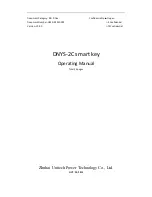
Subject to change without notice
15
X-Y Operation
For
X-Y operation
, the pushbutton in the X field marked
XY
must be depressed. The X signal is then derived from
the
INPUT CH II (X)
.
The calibration of the X signal
during X-Y operation is determined by the setting of
the Channel II input attenuator and variable control.
This means that the sensitivity ranges and input
impedances are identical for both the X and Y axes.
However, the
Y-POS.II
control is disconnected in this
mode. Its function is taken over by the
X-POS.
control. It
is important to note that the
X-MAG. (x10)
facility,
normally used for expanding the sweep, should not be
operated in the X-Y mode. It should also be noted that the
bandwidth of the X amplifier is
≥
3MHz (
−
3dB), and therefore
an increase in phase difference between both axes is
noticeable from 50kHz upwards.
The inversion of the X-input signal using the
INVERT CH.II
button is not possible.
Lissajous figures can be displayed in the X-Y mode for
certain measuring tasks:
−
Comparing two signals of different frequency or bringing
one frequency up to the frequency of the other signal.
This also applies for whole number multiples or fractions
of the one signal frequency.
−
Phase comparison between two signals of the same
frequency.
Phase comparison with Lissajous figures
The following diagrams show two sine signals of the
same frequency and amplitude with different phase angles.
Calculation of the phase angle or the phase shift between
the X and Y input voltages (after measuring the distances
a
and
b
on the screen) is quite simple with the following
formula, and a pocket calculator with trigonometric
functions. Apart from the reading accuracy, the signal
height has no influence on the result.
The following must be noted here:
−
Because of the periodic nature of the trigonometric
functions, the calculation should be limited to angles
≤
90°. However here is the advantage of the method.
−
Do not use a too high test frequency. The phase shift
of the two oscilloscope amplifiers of the HM 303 in the
X-Y mode can exceed an angle of 3° above 120 kHz.
−
It cannot be seen as a matter of course from the screen
display if the test voltage leads or lags the reference
voltage. A CR network before the test voltage input of
the oscilloscope can help here. The 1 M
Ω
input resis-
tance can equally serve as R here, so that only a
suitable capacitor C needs to be connected in series. If
the aperture width of the ellipse is increased (compared
with C short-circuited), then the test voltage leads the
reference voltage and vice versa. This applies only in
the region up to 90° phase shift. Therefore C should be
sufficiently large and produce only a relatively small just
observable phase shift.
Should both input voltages be missing or fail in the
X-Y mode, a very bright light dot is displayed on the
screen. This dot can burn into the phosphor at a too
high brightness setting (INTENS. knob) which causes
either a lasting loss of brightness, or in the extreme
case, complete destruction of the phosphor at this
point.
Phase difference measurement
in DUAL mode
A larger phase difference between two input signals of
the same frequency and shape can be measured very
simply on the screen in Dual mode (
DUAL
button
depressed). The time base should be triggered by the
reference signal (phase position 0). The other signal can
then have a leading or lagging phase angle. Alternate
mode should be selected for frequencies
≥
1 kHz; the
Chop mode is more suitable for frequencies <1 kHz (less
flickering).
For greatest accuracy adjust not much more than one
period and approximately the same height of both signals
on the screen. The variable controls for amplitude and
time base and the
LEVEL
knob can also be used for this
adjustment without influence on the result. Both base
lines are set onto the horizontal graticule center line with
the
Y-POS
. knobs before the measurement. With
sinusoidal signals, observe the zero (crossover point)
transitions; the sine peaks are less accurate. If a sine
signal is noticeably distorted by even harmonics, or if a d.c.
voltage is present,
AC
coupling is recommended for
both
channels. If it is a question of pulses of the same shape,
read off at steep edges.
a
b
2
√
( )
cos
ϕ
ϕ
ϕ
ϕ
ϕ
=
1
−−−−−
a
b
ϕϕϕϕϕ
= arc sin
a
b
sin
ϕ
ϕ
ϕ
ϕ
ϕ
=
















































